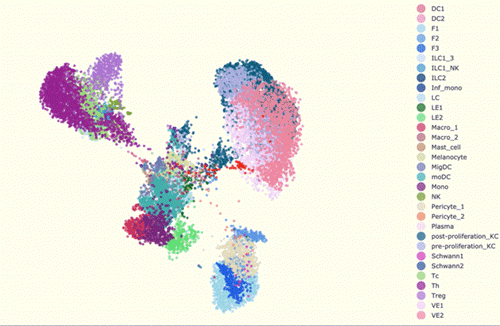
Using a detailed map of the skin, researchers in the U.K. discovered that skin from eczema and psoriasis patients shares many of the same molecular pathways as developing skin cells. This finding could lead to new drug targets for treating skin conditions.
Published online ahead of print in the journal Science (Jan. 22, 2021), the study led by researchers at the Wellcome Sanger Institute, Newcastle University and King’s College London in the U.K. provides a new understanding of inflammatory disease. These findings could open new opportunities for research on other inflammatory diseases such as rheumatoid arthritis and inflammatory bowel disease.
The global Human Cell Atlas aims to map every cell type in the human body. According to the study’s authors, the comprehensive atlas of developing and adult skin is a valuable resource for scientists. It can also provide a template for regenerative medicine, helping researchers grow skin in the laboratory more effectively. The Skin Cell Atlas is an offshoot of the Human Cell Atlas project.
“This Skin Cell Atlas reveals specific molecular signals sent by healthy developing skin to summon immune cells and form a protective layer,” said Dr. Muzlifah Haniffa in a press release. Dr. Haniffa is a co-senior author of the study, a professor at Newcastle University and Associate Faculty at the Wellcome Sanger Institute. “We were amazed to see that eczema and psoriasis skin cells were sending the same molecular signals, which could over-activate immune cells and cause the disease. This had never been seen before. Discovering that developing cell pathways re-emerge is a huge leap in our understanding of inflammatory skin disease and offers new routes for finding treatments.”
To learn how skin forms and how this relates to adult health and disease, the authors of the study investigated cells from developing skin and compared it with biopsies from healthy adults as well as eczema and psoriasis patients.
Using single-cell gene expression analysis and machine learning, the study’s authors analyzed more than half a million individual skin cells to see exactly which genes were switched on in each cell. This allowed them to find out what each cell does and how the cells talk to each other.
The researchers discovered that the diseased skin cells shared many of the same cellular mechanisms as developing cells.
“While our study focused on inflammatory skin disease, there is potential that other inflammatory diseases such as rheumatoid arthritis or inflammatory bowel disease could be triggered in the same way,” said Dr. Gary Reynolds, a clinical lecturer in rheumatology at Newcastle University and the first author on the study.
“This research shows the importance of studying development and could open up entirely new avenues for inflammatory disease research."
The study displayed how healthy skin tissue develops and revealed the cells that are present in adult skin. According to the researchers, this has great implications for regenerative medicine, especially for burn victims.
“There have been decades of research on skin cells grown in the laboratory,” said Dr. Fiona Watt, Director of the Centre for Stem Cells & Regenerative Medicine at King’s College London and co-senior author on the study. “However, it is not always clear how the properties of the cells change in the laboratory setting.
“By revealing the detailed make-up of cells immediately on isolation from developing and adult human skin, this Skin Cell Atlas can act as a template for researchers trying to reconstruct healthy skin in regenerative medicine. Our data is openly available, and we hope this will aid research into creating skin tissue in the laboratory."
